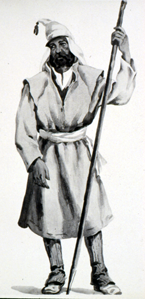Salto del pastor (Gran Canaria)
- Name of sport (game): Salto del pastor
- Name in native language: Salto del pastor
- Place of practice (continent, state, nation):
Canary Islands, Gran Canaria
- History:
The Salto del Pastor Canario, is an activity spread throughout the Canary Archipelago, and that has its origin in the pastoral world, like the fight of the club.
The Canarian shepherd had to adapt to the rugged island terrain for his commuting and his daily tasks, for that reason he helped himself with a long wooden stick, generally of the Canary Island Pine (Pinus canariensis) with a termination, in a metallic point; in the past, the end was sharpened or ended in an animal horn point, called a spit. - Description:
Depending on the area of the Island or the Archipelago, it was called in a certain way, in Gran Canaria it is called Garrote.
The length of this working tool was a function of the place where the grazing was carried out, being shorter in areas of the Coast and Midlands, than in the areas of Summit; in turn, the stick was also used as a combat weapon between different rival factions that fought to use the same space destined to feed the cattle.
El Garrote in Gran Canaria consists of the following different parts
El palo: it is the main instrument through which the shepherd slides, built in wood, although depending on the island different species are used. In the case of Gran Canaria, the normal thing is that it was made with Canary Pine wood (Pinus canariensis), although we can also find specimens made of barbuzano, almond, eucalyptus, etc.
El regatón: it is located at one end of the stick. It is made of iron or steel. The spike is nailed to the ground as a support point, to later slide on the stick. It is composed of a hollow part called a cube or cup, where the wood is introduced. The other part is solid in the shape of a cube or quadrangular pyramid that ends in a point.
Anilla: it is a metallic cover placed at the opposite end of the spout, either so that the wood does not open, or as an ornament. Leather and in some cases goat horns are also used. This element is not used in all the Islands.
There is no fixed measure for the club. The measurements usually range between two and four meters. The measurement depends on where the club is used, since at the top it is usually higher because the orography is more rugged, while in the mid-coast and coastal areas it is usually shorter since the relief is less.
The regatón oscillates between fourteen and thirty-eight centimeters, keeping a direct relationship with the length of the stick.
The puyas or puyones are part of the regatón, and are between five and twelve and a half centimeters, depending on the type of regatón.
- Sources of information :
Books:
Noda Gómez, T., La elaboración de la lanza del salto del pastor, en El PAJAR. Cuaderno de Etnografía Canaria. Asociación Cultural "Día de las Tradiciones Canarias". Pinolere. II Época, nº 7, Agosto 2000, Anual, La Orotava, Tenerife
Video:
https://www.youtube.com/watch?v=WpAj_WFOJng&fbclid=IwAR34gOo-XfoMzNrLQJ5Y6Za6vjzFAZhw3Q_9FMZBes5qYayYPFHyDbD6yVk
https://www.youtube.com/watch?v=tVhfUEjoGV4&fbclid=IwAR26ndbFhvfHwxVPsQNG695a_w-RFO-Pe02nIT67wV5AfJZ5BG85HHELnCY
https://www.youtube.com/watch?v=-P0t3uAyp5E&fbclid=IwAR38Hxdv2ppc-DC4Nu5vk901NwECFS0b9EvlMGG1trZowptdB9IHMorDBrM

